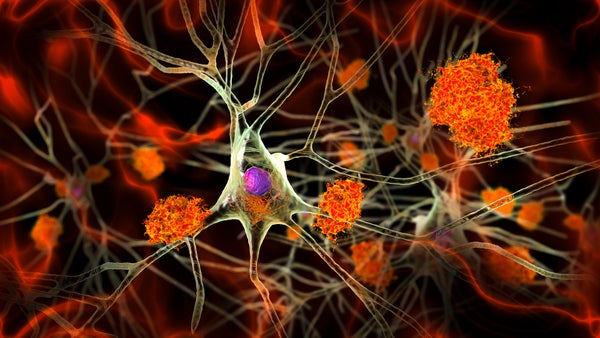Researchers have identified a man with a rare genetic mutation that protected him from developing dementia at an early age. The finding, published on 15 May in Nature Medicine, could help researchers to better understand the causes of Alzheimer’s disease and potentially lead to new treatments.
For nearly 40 years, neurologist Francisco Lopera at the University of Antioquia in Medellín, Colombia, has been following an extended family whose members develop Alzheimer’s in their forties or earlier. Many of the approximately 6,000 family members carry a genetic variant called the paisa mutation that inevitably leads to early-onset dementia. But now, Lopera and his collaborators have identified a family member with a second genetic mutation — one that protected him from dementia until age 67.
“Reading that paper made the hair on my arms stand up,” says neuroscientist Catherine Kaczorowski at the University of Michigan in Ann Arbor. “It’s just such an important new avenue to pursue new therapies for Alzheimer’s disease.”
Mutated protein
Lopera and his colleagues analysed the genomes and medical histories of 1,200 Colombians with the paisa mutation, which causes dementia around ages 45—50. They identified the man with the second mutation when he was 67 and had only mild cognitive impairment.
When the researchers scanned his brain, they found high levels of the sticky protein complexes known as amyloid plaques, which are thought to kill neurons and cause dementia, as well as a protein called tau that accumulates as the disease progresses. The brain looked like that of a person with severe dementia, says study co-author Joseph Arboleda, an ophthalmologist at Harvard Medical School in Boston. But one small brain area called the entorhinal cortex, which coordinates skills such as memory and navigation, had low levels of tau.
The researchers found that the man had a mutation in a gene coding for a protein called reelin, which is associated with brain disorders including schizophrenia and autism. Little is known about reelin’s role in Alzheimer’s, so the researchers genetically engineered mice with the same mutation. In mice, the mutated form of reelin caused the tau protein to be chemically modified, limiting its ability to cluster around neurons.
The study challenges the theory that Alzheimer’s disease is primarily driven by amyloid plaques, which are the targets of several drugs recently approved by the US Food and Drug Administration. The drugs effectively remove amyloid from the brain, but lead to only a moderate improvement in rates of cognitive decline.
The fact that the man stayed mentally healthy for so long despite the many amyloid plaques in his brain suggests that Alzheimer’s is more complicated, says Yadong Huang, a neurologist at the Gladstone Institutes in San Francisco, California. He suggests that there could be multiple subtypes of Alzheimer’s, only some of which are driven by amyloid. “We do need different pathways to really finally deal with this disease,” he says. The link to tau, he says, is especially promising because it suggests that tau plays a role in mental decline. Several therapies targeting tau are currently in clinical trials.
Shared mechanisms
Lopera says that the reelin mutation is extremely rare in the general population, but that his team is now looking for this and other mutations among people with the paisa mutation. The man’s sister, who had both the paisa and reelin mutations, began developing cognitive impairment at age 58 and severe dementia at 64 — later than average for someone with the paisa mutation. The authors say that she had experienced head injuries and had other disorders that could have contributed to her developing dementia earlier than her brother.
Arboleda notes that the mutated reelin protein binds to the same receptors as a protein called APOE, which is also associated with Alzheimer’s disease in people who do not have the paisa mutation. In 2019, the same group had identified a woman with the paisa mutation who developed dementia 30 years later than average, owing to a mutation in APOE. Like the man in the latest study, the woman’s brain contained much higher levels of amyloid than would be expected in someone with so few Alzheimer’s symptoms.
“It’s really cool because it’s telling us there’s some shared mechanisms,” Kaczorowski says. Reelin and APOE compete to bind to the receptor, and the two findings suggest that either a stronger reelin protein or a weaker APOE protein can protect the brain against the disease. Arboleda says this suggests that therapies targeting reelin or APOE might be even more effective in sporadic Alzheimer’s cases, which tend to be less aggressive and progress more slowly than the early-onset type that the Colombian family experiences.
As with many people with Alzheimer’s, the man’s hippocampus — a brain region controlling learning and memory — was smaller than average at the time of his death, suggesting that it was degenerating. But because his cognitive abilities remained relatively intact, Kaczorowski says, neurons in other parts of the brain might have repurposed themselves to make up for the damage. Knowing whether that happens, she adds, could help to inform future therapeutic strategies.
“The vast majority of research focuses on why some people have Alzheimer’s, very few are on conditions where a factor can go against this disease,” says Huang. He says that further research is needed to pin down the mechanism through which reelin and APOE affect tau, and whether targeting these proteins could help people with Alzheimer’s who do not have the paisa mutation. “This is one of those few cases that really opens the door for anti-Alzheimer’s research.”
This article is reproduced with permission and was first published on May 15, 2023.
